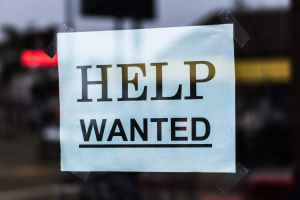 There are three reasons for the current labor shortage.
There are three reasons for the current labor shortage.
Two are signs of failure. One is a sign of success.
First, the failures.
The refusal of many employers, especially in the food service industry, to pay a living wage has long been a disgrace. They got away with it, in part, because America welcomed millions of immigrants, especially from Latin America. With the flow cut off, and other workers forced to fend for themselves for nearly a year, is it any wonder they won’t come back without more money?
This statement is controversial. I have friends who insist “people don’t want to work,” because they get more money not working. It’s not true, but my friends won’t budge. It might be because these friends are locked-in to their current positions, their current pay scale, their current lifestyle. I hate to say this of people I love, but there’s also some racism involved.
 Second, there’s a failure of our education system. This is more important. The world of education has become entirely separate from the world of work. No mentoring is happening, except in elite schools. Colleges are producing degrees when they should be producing trained workers.
Second, there’s a failure of our education system. This is more important. The world of education has become entirely separate from the world of work. No mentoring is happening, except in elite schools. Colleges are producing degrees when they should be producing trained workers.
It’s not just a failure to teach the skills of work. They fail to teach anything about how to deal with working. Their view on getting a job is a generation out of date (no one needs a resume). Their connections to employers are minimal. Teachers at all levels think they’re better than, or at least different from, employers of all sorts.
The disconnect means a generation of kids have been trained for jobs that don’t exist, and don’t know how to connect to jobs that do. Private, for-profit schools, which claimed they would fill the gap, turned out to be garbage. Our kids, those age 18-40, have been left behind. Even if the problems are fixed, millions will remain behind for the rest of their lives.
Then there’s Moore’s Law. Technologists had been building a work-from-home revolution for decades. I joined in 1983. When the pandemic hit, millions of office workers were forced to join the revolution. For most, it was good. My own wife, for instance, has saved at least 2 ½ hours each day for sleep. She gets her exercise walking during Zoom meetings. When her employer announced a return to work plan, closing her office for one an hour further away, she made sure to get her at-home workstyle made permanent.
 Employers gained productivity during the pandemic and saw they could cut other costs. Many workers found they became more productive and saw lower costs for clothes, food, and transportation. They also found time to deal with their lives, with their families, with their health, time that didn’t exist before.
Employers gained productivity during the pandemic and saw they could cut other costs. Many workers found they became more productive and saw lower costs for clothes, food, and transportation. They also found time to deal with their lives, with their families, with their health, time that didn’t exist before.
These changes are permanent. They mean more competition for skilled labor unbound by geography. In some cases, as with Rackspace, it means outsourcing work overseas. There has long been a “race to the bottom” among some technology firms, and that will accelerate.
But the result is lower costs. The result is deflation, serious deflationary pressure I think will eliminate any inflation now coursing through the economy within two years. Unless new sources of demand are found. Or labor gets some huge raises.










